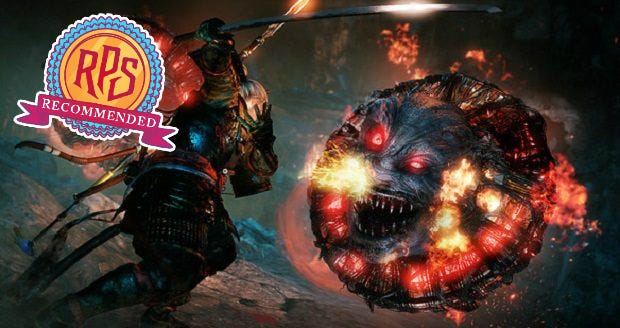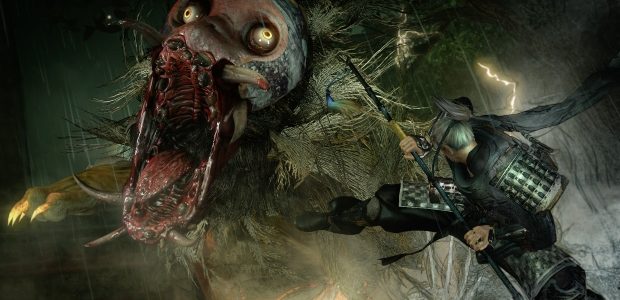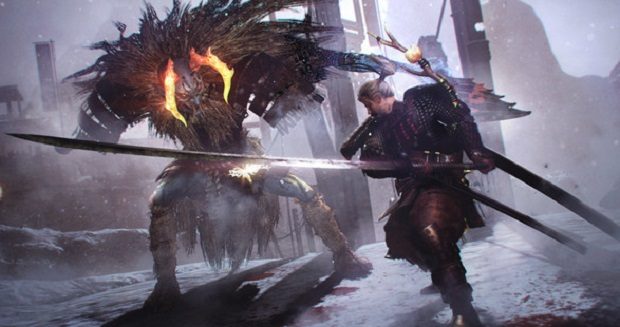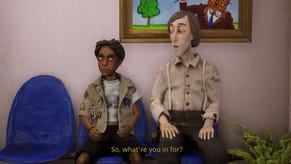Wot I Think: Nioh - Complete Edition
Soulsful
Describing a game as X meets Dark Souls is a sure way to invite mockery and contempt. It's lazy critical short-hand, people will say, and they're often correct. Well, prepare to mock. But only a little.
I promise I'm not being lazy when I say that Nioh is Dark Souls meets Sengoku period Japan though, and to prove it I'm going to use that short-hand as a starting point rather than an end-point. Fortunately, where Nioh differs from Dark Souls is far more interesting than where the two games overlap.
In Dark Souls, I find myself replaying areas over and over again because I need to, whereas in Nioh I make the return journey deliberately. The mission selection map shows that a new threat has taken hold in a village I've already cleared, or that those mines are infested again and I dig into my wardrobe, pick out my fanciest outfit, and head back into the fray.
The areas range from the Tower of London to burning villages and demon-swarmed battlefields. None have the weird architectural and layout quirks I associate with the best of the Souls games, and they're all discrete areas accessed via that map screen. There's no attempt to connect them into a cohesive whole, as you may have realised given that most of the game is set in Japan while the Tower of London is indeed in London.
Immediately, the lack of interconnectivity distances Nioh from its Soulsful inspiration. I also expected it to be a mark against the game, given how important the looping labyrinths of From Software's trilogy are to the sense of exploration and dread. The actual design of the individual areas in Nioh, in terms of both visuals and layout, is far simpler as well. I never found myself struck with the sense of awe and mystery that Dark Souls so often inspires, when I became an amateur archaeologist down in its undying ruins.
It'd be easy to look at Nioh and think it's borrowed Dark Souls' favourite hat and coat, but is wearing them all wrong. I wouldn't have spent fifty hours with the PS4 version if it didn't have something to offer though, and in fact it's the way that Team Ninja have remixed the Souls formula, adding just enough ARPG-style looting and collecting, that makes it stand out from its inspiration. It might have borrowed the hat and coat, but it's got an enormous wardrobe of its own to accessorise with, and the joy of dressing up is a very real part of the experience.
Rather than having a few armour sets and weapons with important backstories and unique abilities and stats, Nioh throws swords, guns, bows, trousers and hats at you as if it's trying to make up for a lifetime of missed birthdays and Christmases. Every enemy is a potential giftbox just waiting to be cracked open and I quickly became intimidated by the sheer quantity of stuff clogging up my inventory.
Fortunately, it's easy to sort, however you might want to sort it. Just want to go with whatever has the highest ratings? Nioh lets you do that. Want to pick a certain type of weapon? Sure thing. Interested in ranking by rareness? OK.
I ended up hoovering up a lot of rubbish, sometimes really snazzy-looking rubbish, as I carved my way through Nioh's monstrosities, but the initial feeling of being overwhelmed soon passed and I settled into a rhythm. And that's Nioh's great strength, that sense of rhythm. It's most obvious in the excellent combat system, which is fast, flowing and demanding, but it's also noticeable in the sense of progression and inventory management. In among the stacks of low-level junk dropping out of enemies, there are rich veins of quality. Whether it's a particularly fine piece of armour, either completing a look you've been refining for a couple of hours, or a particularly excellent example of a weapon type you've never spent much time with, the loot system is designed to prompt changes in playstyle.
And it's the combat, which is Nioh's core, that shows how flexible your character can be. He always looks a bit like Geralt playing dress-up in a new world of horrors, but you can make him your own.
A few hours in, I was confidently switching between stances and weapons. In one fight, I'd begin with a lumbering set of heavy smashes and swings using a legendary odachi, and finish with rapid flurries of stabs, kicks and dives delivered with a small but swift katana. Every fight has a tactical element, whether you're luring a soldier into a narrow path or toward a cliff edge, or feinting and pirouetting between spheres of corruption, purifying them to recharge your stamina and weaken your opponents.
Many demons can leave their mark on the world, creating temporary localised dead zones that prevent your skills from recharging. To counter them, you push the right button at just the right time, making most encounters reliant on a combination of positioning, timing and planning. It's exhilarating, rewarding skill and reflexes rather than simply relying on equipment levels, and I can't think of a combat system I've enjoyed more in any RPG.
It's unfair to compare Nioh to other RPGs though because it leans so heavily into that combat system that it really has more in common with Devil May Cry and the like than with even the action-heavy design of a Souls game. While it's not as kinetic as a pure character action game and not quite as stylish, Nioh is more in line with what I'd want from a modern Streets of Rage than anything else. It's a series of superb fights, book-ended by bosses of varying quality.
They're often great, the bosses, but they sometimes make the mistake of throwing new rules into the mix that ignore or circumvent the skills you've learned in the build-up to the big showdown. That said, I never felt anything less than ecstatically heroic when I finally managed to kill each of them.
Even when I don't appreciate their attack patterns or the little tricks and secrets required to best them, the bosses, like the rest of the creatures, always impressed me. That's because they look great. Horrible and inventive, the designs draw on Japanese mythology and are as weird and fascinating as any menagerie I've ever come across. It's rare that I want to dig as deep into bestiary descriptions as I did here, even if the story that holds all of the lore together feels flimsy.
There are historical characters aplenty and it's probably entirely possible to get invested in the rewriting of great battles that incorporates spiritual invasions and talking cats into the mix, but although I enjoyed some moments either for their silliness or their impressive scale, I'd have been quite happy skipping the lot. Nioh is a game about perfecting a fighting style, or several fighting styles, and every time it slows down to justify that in any way, I want to hurry it along.
Oddly, it's in the story that the mission select screen and disconnected levels break the flow the most. The way new side missions and high difficulty versions of completed maps unlock makes it very clear that forward momentum through a plot isn't a serious concern at all; Nioh is all about enjoying the moment. Or moments, rather. Tens of hours of them.
It's massive. After a fairly naff tutorial mission, you're dropped into the first proper area out in Japan and you could vanish into the game for days at that point. You can fight the ghosts of other players or trigger mini-boss fights, you can hunt down shrines to unlock new mystical ninja abilities. I sometimes forget what the actual objective I'm supposed to be focusing on is because there are so many tempting distractions at every turn.
Finish a level and there's most likely a reason to return rather than moving onto the next one. Strip away all of the other reasons as to why you'd return and, yes, it's probably to grind for better gear, but every new mission changes enemy positioning and even basic functions of a map's layout. I never found myself taking repeat trips in the hope of a better equipment drop – as I might in, say, Destiny – because I was always learning how to play the game better rather than simply waiting for it to allow my character to be good enough to pass the next hurdle.
Unfortunately, also unlike Destiny, Nioh's journey from console to PC has not been completely smooth. The game has no mouse and keyboard support to speak of, in menus or in game. You would likely be better off playing a game like this with a controller anyway, but it's still an annoyance. Otherwise things are mostly fine: you have to change resolution in the launcher rather than via an in-game menu, but there's support for 4K resolutions, it seems to run well enough on older PCs, and you can choose whether to cap it at 30 or 60 frames per second.
Nioh is like Dark Souls in so far as the halts to progress and forced repetition of fights function. You move forward, you fall, you learn, you try again. Experience works almost identically, tied to a form of currency that must be cashed in before death, adding a delicious risk/reward factor. The masses of loot initially seem like the biggest difference between this and a From Software game, and could kid you into thinking Nioh is a game about raising stats above all else, but it's not. That's a small part of it. Really, it's a game about raising your own level and mastering one of the finest combat systems ever put on a screen. It might be standing on the shoulders of Souls, but it's got its eyes on a very different destination.
Nioh: Complete Edition is out on Windows PC today and is available via Steam for £39.99.













